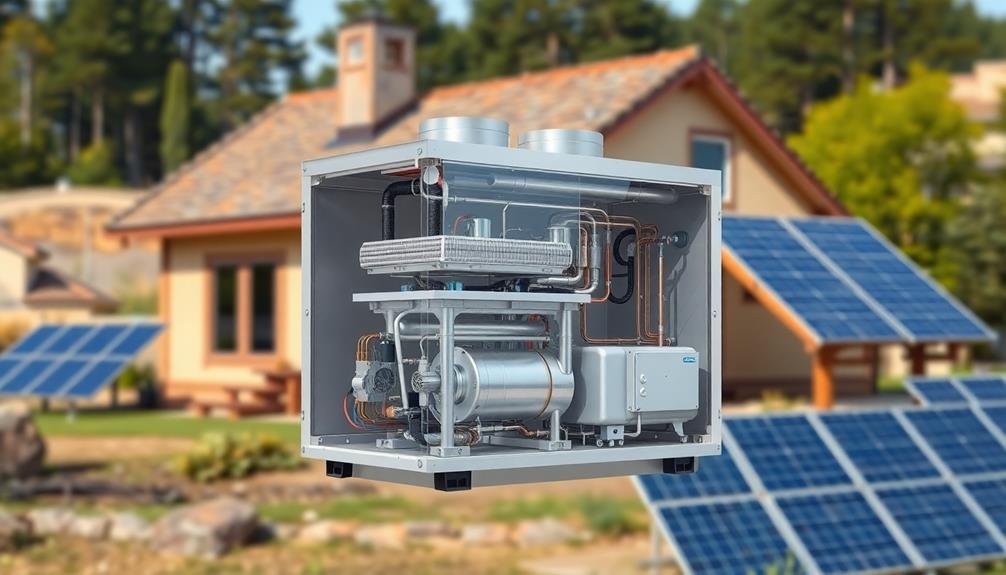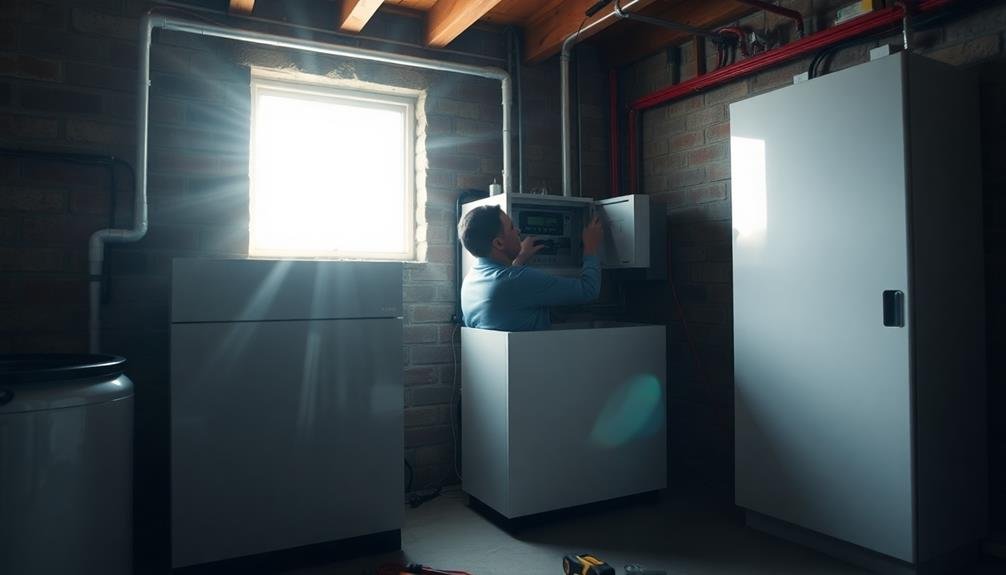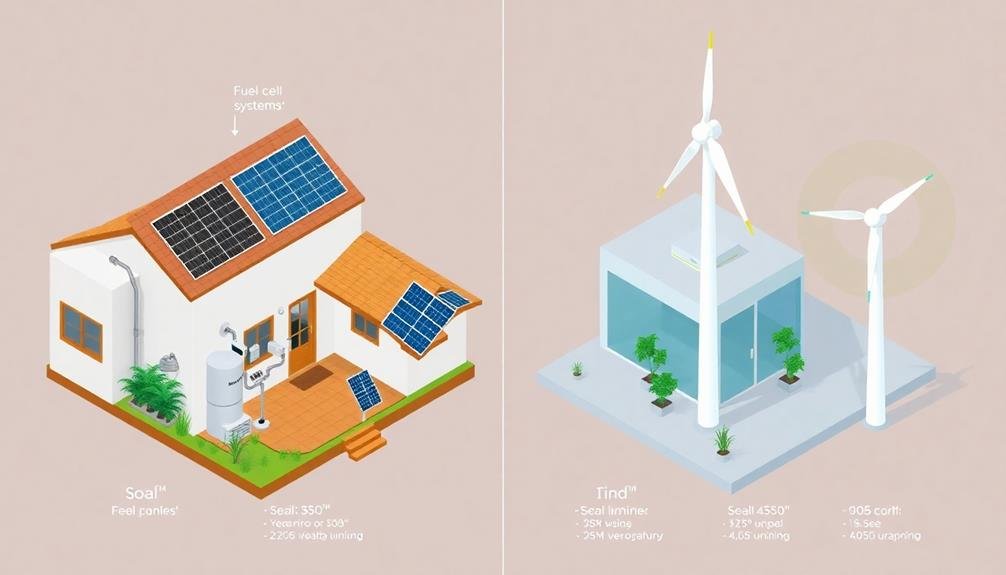Fuel cells for off-grid home power are efficient devices that convert chemical energy into electricity without combustion. They offer a clean, reliable alternative to traditional generators, providing continuous power with low emissions. You'll find different types, like PEM and solid oxide fuel cells, each with unique advantages. These systems can run on various fuels, including hydrogen and natural gas, making them versatile for remote locations. While they have high upfront costs, fuel cells boast low maintenance, quiet operation, and scalability to meet your energy needs. Understanding the components, installation process, and regulatory considerations will help you determine if this technology is right for your off-grid home.
Understanding Fuel Cell Technology

In recent years, fuel cell technology has emerged as a promising solution for off-grid home power. You'll find that fuel cells are electrochemical devices that convert chemical energy from fuel into electricity through a reaction with oxygen. Unlike traditional batteries, fuel cells don't run down or require recharging; they'll continue to produce electricity as long as fuel is supplied.
The most common type for residential use is the proton exchange membrane (PEM) fuel cell. It uses hydrogen as fuel and operates at relatively low temperatures, making it suitable for homes. You'll appreciate its quiet operation and high efficiency, often exceeding 50%.
When you're considering fuel cells for your off-grid home, you'll need to understand their components. These include the fuel processor, which converts fuel into hydrogen; the fuel cell stack, where the electrochemical reaction occurs; and the power conditioner, which converts the direct current output into usable alternating current.
You'll find that fuel cells offer several advantages for off-grid living, including low emissions, high reliability, and the ability to scale power output by adding more cells.
Types of Home Fuel Cells
Homeowners exploring fuel cell options for off-grid power will encounter several types suitable for residential use. The most common are Proton Exchange Membrane (PEM), Solid Oxide Fuel Cells (SOFC), and Phosphoric Acid Fuel Cells (PAFC).
PEM fuel cells are popular for homes due to their low operating temperature and quick start-up time. They're efficient and can use a variety of fuels, including hydrogen and natural gas. SOFCs operate at higher temperatures, making them ideal for combined heat and power systems. They're highly efficient but require more time to start up. PAFCs are less common in residential settings but offer high reliability and can use impure hydrogen sources.
Here's a comparison of these fuel cell types:
| Type | Efficiency | Operating Temp | Start-up Time |
|---|---|---|---|
| PEM | 40-60% | 80°C | Quick |
| SOFC | 50-60% | 800-1000°C | Slow |
| PAFC | 40-50% | 150-200°C | Moderate |
When choosing a fuel cell for your off-grid home, consider factors like efficiency, fuel availability, and your power needs. Each type has its strengths, so you'll need to weigh these against your specific requirements to find the best fit.
Fuel Cell Components

You'll find that fuel cells consist of several key components working together to generate electricity.
These parts include the anode, cathode, electrolyte, and catalyst, each playing a vital role in the electrochemical process.
Understanding the materials and construction of these components is essential for grasping how fuel cells function and their potential for off-grid home power systems.
Key Parts Explained
Understanding the key components of a fuel cell is vital for homeowners considering this technology for off-grid power. At its core, a fuel cell consists of an anode, cathode, and electrolyte. The anode is where hydrogen fuel is introduced, while the cathode receives oxygen from the air. The electrolyte, sandwiched between them, facilitates ion transfer.
You'll find several other significant parts in a fuel cell system:
- Catalyst: Speeds up the chemical reactions
- Gas diffusion layers: Distribute gases evenly across the electrodes
- Bipolar plates: Conduct electricity and manage heat and water
- Fuel processor: Converts hydrocarbon fuels into hydrogen
- Power inverter: Converts DC output to AC for home use
The catalyst, often made of platinum, is key to the fuel cell's efficiency. Gas diffusion layers guarantee ideal reactant distribution, while bipolar plates help manage the system's overall performance.
For off-grid applications, you'll need a fuel processor if you're not using pure hydrogen. Finally, the power inverter makes the electricity usable for your home appliances. Understanding these components will help you make informed decisions about implementing fuel cell technology in your off-grid power system.
Materials and Construction
Fuel cell construction relies on carefully selected materials to guarantee ideal performance and durability. The heart of a fuel cell is the membrane electrode assembly (MEA), which consists of a proton exchange membrane sandwiched between catalyst layers and gas diffusion layers.
You'll find that the membrane is typically made of a polymer called Nafion, known for its excellent proton conductivity and chemical stability.
The catalyst layers, essential for facilitating the electrochemical reactions, often use platinum or platinum alloys due to their high catalytic activity. These are applied to carbon-based supports to increase surface area and efficiency.
The gas diffusion layers, made of carbon paper or carbon cloth, allow reactants to reach the catalyst sites while managing water content.
For the bipolar plates, you'll see materials like graphite, stainless steel, or titanium used. These plates distribute reactants, collect current, and provide structural support.
The housing and sealing components are usually made of durable plastics or metals to withstand operating conditions.
Careful material selection and precise construction techniques guarantee that your fuel cell operates efficiently and reliably in your off-grid power system.
Advantages of Fuel Cells
When it comes to powering off-grid homes, fuel cells stand out with several key advantages. These innovative power sources offer a reliable and efficient alternative to traditional generators or solar panels. Fuel cells can provide continuous electricity, making them ideal for remote locations where consistent power is essential.
One of the most significant benefits of fuel cells is their high energy efficiency. They convert fuel directly into electricity without combustion, resulting in minimal energy loss. You'll also appreciate their low environmental impact, as fuel cells produce clean energy with minimal emissions.
Here are five key advantages of fuel cells for off-grid home power:
- Quiet operation
- Low maintenance requirements
- Scalability to meet various power needs
- Long lifespan compared to other power sources
- Ability to use diverse fuel types, including hydrogen and natural gas
Fuel cells can operate in various weather conditions, unlike solar panels that depend on sunlight. They're also more compact than many other power systems, saving valuable space in your off-grid home.
With advancements in technology, fuel cells are becoming increasingly affordable and accessible for homeowners seeking reliable, sustainable off-grid power solutions.
Drawbacks of Fuel Cell Systems

Despite their impressive advantages, fuel cell systems come with their fair share of challenges. You'll find that the initial cost of installing a fuel cell system for your off-grid home can be quite high. The technology is still relatively new, which means prices haven't yet dropped to more affordable levels for many homeowners.
Another drawback you'll encounter is the complexity of fuel cell systems. They require specialized knowledge for installation, maintenance, and repairs. This can make it difficult to find qualified technicians in your area, potentially leading to higher service costs and longer downtime if issues arise.
You'll also need to take into account fuel availability. While hydrogen is abundant, it's not always easily accessible in its pure form. You may need to invest in additional equipment to produce or store hydrogen on-site, adding to the overall system cost and complexity.
Fuel cells can be sensitive to temperature fluctuations and contaminants, which might affect their performance in certain environments.
Additionally, the lifespan of fuel cell stacks is limited, typically ranging from 5 to 15 years, meaning you'll need to factor in replacement costs over time.
Cost Analysis
When considering fuel cells for off-grid home power, you'll need to weigh the financial aspects carefully.
Your cost analysis should start with the initial investment, which includes the fuel cell system and installation, then factor in ongoing operational expenses like fuel and maintenance.
To determine if it's a viable option for you, compare the long-term costs of a fuel cell system to other off-grid alternatives, such as solar or wind power.
Initial Investment
Anyone contemplating fuel cells for off-grid home power should be prepared for a substantial initial investment. The upfront costs can be significant, often ranging from $10,000 to $50,000 or more, depending on the system's size and complexity. This investment covers not only the fuel cell itself but also additional components necessary for a complete off-grid setup.
Your initial investment will typically include:
- The fuel cell stack
- Inverters and power conditioning equipment
- Fuel storage and delivery systems
- Backup batteries
- Installation and integration costs
While these costs may seem overwhelming, it's important to reflect on the long-term benefits. Fuel cells offer reliable, clean energy with lower maintenance requirements compared to traditional generators.
They're also more efficient than many other power sources, potentially leading to lower fuel costs over time. Additionally, some areas offer incentives or tax credits for installing alternative energy systems, which can help offset the initial investment.
As you weigh the costs, contemplate your energy needs, budget, and the potential for long-term savings before making a decision on fuel cells for your off-grid home power solution.
Operational Expenses
While the initial investment for fuel cells is significant, you'll also need to contemplate the ongoing operational expenses. The primary operational cost is the fuel itself, typically hydrogen or natural gas. Hydrogen prices can vary widely depending on your location and production method, while natural gas costs are generally more stable but subject to market fluctuations.
You'll incur maintenance expenses for regular inspections, filter replacements, and occasional repairs. Most fuel cell systems require professional servicing every 1-3 years, which can cost several hundred dollars per visit.
Additionally, you may need to replace certain components, such as the fuel cell stack, every 5-10 years, depending on usage and system quality.
Electricity costs for auxiliary equipment, like pumps and control systems, should also be factored in. While these are typically low, they contribute to your overall operational expenses.
Water consumption for some fuel cell types is another consideration, though it's usually minimal.
Lastly, don't forget about potential insurance premium increases for your home due to the presence of a fuel cell system. While these costs can add up, they're often offset by the savings from reduced or eliminated grid electricity usage.
Long-Term Cost Comparison
To accurately assess the financial viability of fuel cells for off-grid home power, you'll need to perform a long-term cost comparison. Contemplate factors such as initial investment, operational expenses, and potential savings over time.
Compare fuel cells to other off-grid power options like solar panels, wind turbines, or generators.
When conducting your cost analysis, factor in:
- Initial equipment and installation costs
- Fuel expenses (hydrogen or natural gas)
- Maintenance and replacement costs
- System lifespan and efficiency degradation
- Potential government incentives or rebates
Remember that fuel cells often have higher upfront costs but may offer lower operational expenses and longer lifespans than some alternatives. They can provide consistent power output regardless of weather conditions, unlike solar or wind systems.
However, fuel availability and price fluctuations can impact long-term costs.
To make an informed decision, calculate the total cost of ownership over a 10-20 year period for each option. This approach will help you determine if fuel cells are the most cost-effective solution for your off-grid power needs.
Don't forget to contemplate your specific energy requirements and location when making comparisons.
Installation Process

How can you transform your off-grid home with a fuel cell system? The installation process involves several key steps that you'll need to follow carefully. First, assess your energy needs and choose the right fuel cell system size. Then, prepare the installation site, guaranteeing proper ventilation and safety measures.
Next, you'll need to connect the fuel cell to your home's electrical system. This typically requires professional help to verify compliance with local codes. You'll also need to set up fuel storage and delivery systems, which vary depending on the type of fuel cell you've chosen.
Here's a quick overview of the installation process:
| Step | Action | Key Considerations |
|---|---|---|
| 1 | Site preparation | Ventilation, safety, accessibility |
| 2 | Fuel cell placement | Sturdy foundation, weather protection |
| 3 | Electrical connection | Professional installation, code compliance |
Once installed, you'll need to test the system thoroughly and learn how to operate and maintain it. Regular maintenance is vital for peak performance and longevity. With proper installation and care, your fuel cell system can provide reliable, clean energy for your off-grid home for years to come.
Maintenance Requirements
To keep your fuel cell system running smoothly, you'll need to perform regular system inspections.
You should also be aware of the catalyst replacement schedule, which varies depending on your specific fuel cell model.
Additionally, you'll need to implement proper water management procedures to guarantee peak performance and longevity of your off-grid power system.
Regular System Inspections
Why are regular system inspections essential for fuel cell systems in off-grid homes?
They're vital for maintaining system efficiency, preventing unexpected breakdowns, and ensuring your home's continuous power supply. You'll want to schedule routine inspections to catch potential issues early and extend your fuel cell system's lifespan.
During these inspections, you or a qualified technician should:
- Check for any visible damage or corrosion on system components
- Examine fuel and air filters for blockages or wear
- Verify proper functioning of safety sensors and shut-off valves
- Test electrical connections and inverter performance
- Monitor system efficiency and output levels
Regular inspections help you stay on top of your fuel cell system's health, allowing you to address minor issues before they become major problems.
You'll also gain insights into your system's performance trends, which can inform maintenance schedules and potential upgrades.
By prioritizing these check-ups, you're protecting your investment and ensuring reliable off-grid power for your home.
Catalyst Replacement Schedule
While regular inspections are key to maintaining your fuel cell system, another vital aspect of upkeep is the catalyst replacement schedule. The catalyst is a fundamental component that facilitates the chemical reaction in your fuel cell, and it gradually degrades over time.
You'll need to replace it periodically to guarantee peak performance and efficiency. Typically, you should plan to replace the catalyst every 3-5 years, depending on your system's usage and environmental conditions.
However, some high-performance fuel cells may require more frequent replacements, possibly every 1-2 years. It's important to consult your manufacturer's guidelines for specific recommendations.
Keep a log of your fuel cell's operating hours and performance metrics. If you notice a significant drop in efficiency or power output, it might indicate that your catalyst needs replacement sooner than expected.
When replacing the catalyst, you'll likely need professional assistance, as it involves handling delicate components and potentially hazardous materials. Schedule your replacements in advance to minimize downtime and guarantee continuous power supply for your off-grid home.
Water Management Procedures
Effective water management is essential for maintaining your fuel cell's performance and longevity. You'll need to monitor and control water levels regularly to guarantee ideal operation. Excess water can flood the cell, while insufficient water can lead to membrane damage.
To properly manage water in your fuel cell system, you'll need to understand the water balance and implement appropriate procedures.
Here are key water management tasks you'll need to perform:
- Check water levels in the fuel cell stack daily
- Monitor humidity levels in the reactant gases
- Drain excess water from the system periodically
- Refill the water reservoir as needed
- Inspect and clean water filters monthly
You'll also need to maintain the proper water quality for your fuel cell. Use only distilled or deionized water to prevent mineral buildup and contamination.
Regularly test the water's pH and conductivity to guarantee it meets specifications. If you live in a cold climate, you'll need to take extra precautions to prevent freezing, such as using antifreeze solutions or implementing a heating system.
Fuel Sources and Availability

Fuel cells' versatility shines through in their ability to use various fuel sources. You'll find that hydrogen is the most common fuel, offering clean and efficient energy production. However, you can also use natural gas, propane, or methanol in some fuel cell systems. These alternatives provide flexibility when hydrogen isn't readily available.
For off-grid homes, your fuel source choice depends on local availability and storage capabilities. If you're near a natural gas line, that's a convenient option. Propane tanks offer portability and ease of storage, making them suitable for remote locations. Methanol, while less common, is another liquid fuel that's relatively easy to transport and store.
Hydrogen presents unique challenges for off-grid use. You'll need to either produce it on-site through electrolysis or have it delivered and stored in high-pressure tanks. On-site production requires additional equipment and energy input, while delivery may be impractical for remote areas.
Despite these hurdles, hydrogen remains the cleanest fuel option, producing only water as a byproduct. Consider your location, budget, and environmental priorities when choosing your fuel cell's energy source.
Environmental Impact
The environmental footprint of fuel cells for off-grid home power is remarkably small compared to traditional energy sources. You'll find that these systems produce minimal emissions, primarily water vapor and heat. Unlike fossil fuel-based generators, fuel cells don't release harmful pollutants or greenhouse gases during operation.
When you choose fuel cells for your off-grid home, you're contributing to a cleaner environment. Here are some key environmental benefits:
- Near-zero emissions during operation
- Quiet functioning, reducing noise pollution
- Efficient energy conversion, minimizing waste
- Potential for using renewable hydrogen sources
- Long lifespan, reducing electronic waste
You'll appreciate that fuel cells can operate on various fuels, including hydrogen produced from renewable sources. This flexibility allows you to further reduce your carbon footprint by selecting eco-friendly fuel options.
Additionally, the high efficiency of fuel cells means you'll use less fuel overall, conserving resources and reducing transportation-related emissions.
As you consider off-grid power solutions, remember that fuel cells offer a sustainable alternative that aligns with environmental conservation efforts. You're not just powering your home; you're also making a positive impact on the planet.
Comparing Fuel Cells to Alternatives

When weighing your options for off-grid power, it's important to compare fuel cells against alternative solutions. You'll want to evaluate factors like initial cost, ongoing expenses, reliability, and environmental impact. Fuel cells offer several advantages, including low maintenance, quiet operation, and consistent power output.
Let's compare fuel cells to popular alternatives:
| Feature | Fuel Cells | Solar Panels | Wind Turbines |
|---|---|---|---|
| Initial Cost | High | Moderate | High |
| Fuel Source | Hydrogen/Natural Gas | Sunlight | Wind |
| Weather Dependence | Low | High | High |
| Maintenance | Low | Low | Moderate |
| Lifespan | 10-15 years | 25-30 years | 20-25 years |
While fuel cells have a higher upfront cost, they're less dependent on weather conditions than solar or wind power. You'll find them particularly useful in areas with limited sunlight or inconsistent wind patterns. However, you'll need to take into account the cost and availability of fuel sources. Solar panels offer the lowest maintenance and longest lifespan, but their effectiveness varies with sunlight exposure. Wind turbines can be highly efficient in windy areas but may face zoning restrictions and noise concerns.
Regulatory Considerations
Before installing a fuel cell system for your off-grid home, you'll need to navigate various regulatory factors. Local building codes, zoning laws, and environmental regulations may impact your ability to install and operate a fuel cell system. You'll likely need to obtain permits and undergo inspections to guarantee compliance with safety standards.
Many jurisdictions have specific requirements for off-grid power systems, including fuel cells. You should research and examine the following aspects:
- Fuel storage and handling regulations
- Emissions standards and air quality permits
- Electrical code compliance for grid-independent systems
- Fire safety requirements and setbacks
- Noise ordinances that may affect system placement
It's vital to consult with local authorities and experienced professionals familiar with fuel cell installations in your area. They can guide you through the regulatory process and help you meet all necessary requirements.
Remember that regulations can vary greatly between regions, so what's permissible in one location may not be in another.
Additionally, you'll need to take into account insurance implications. Some insurers may have specific policies or requirements for homes with fuel cell systems. Staying informed and proactive about regulatory considerations will help guarantee a smooth installation process for your off-grid fuel cell system.
Future of Home Fuel Cells

Three key trends are shaping the future of home fuel cells.
First, advancements in materials science are improving fuel cell efficiency and durability. You'll see more robust, longer-lasting fuel cells hitting the market, making them a more attractive option for off-grid power.
Second, the growing focus on renewable energy is driving innovation in hydrogen production. This means you'll have access to cleaner, more sustainable fuel sources for your home fuel cell system.
Third, decreasing costs are making fuel cells more accessible to homeowners. As manufacturing processes improve and demand increases, you can expect prices to continue dropping. This trend will likely accelerate the adoption of fuel cells for off-grid homes.
Looking ahead, you'll see more integrated systems that combine fuel cells with other renewable energy sources like solar and wind. These hybrid setups will offer greater reliability and efficiency.
Additionally, smart home technology will increasingly incorporate fuel cell management, allowing you to optimize your power usage and monitor system performance remotely.
As these trends converge, fuel cells are poised to become a mainstream option for off-grid home power in the coming years.
Frequently Asked Questions
Can Fuel Cells Power an Entire Home During Extended Power Outages?
Yes, fuel cells can power your entire home during extended outages. They're reliable, efficient, and produce clean energy. You'll need a properly sized system and adequate fuel supply. They're especially useful for off-grid or backup power solutions.
Are There Any Safety Concerns With Using Fuel Cells Indoors?
You should be aware of potential safety concerns with indoor fuel cells. They can produce carbon monoxide, so you'll need proper ventilation. There's also a fire risk if hydrogen leaks. Always follow manufacturer guidelines and local regulations for safe operation.
How Noisy Are Fuel Cell Systems Compared to Traditional Generators?
You'll find fuel cells much quieter than traditional generators. They don't have moving parts, so they operate almost silently. You'll only hear a faint hum from auxiliary components like fans or pumps. It's a peaceful power solution.
Can Fuel Cells Be Integrated With Existing Solar or Wind Power Systems?
Yes, you can integrate fuel cells with existing solar or wind power systems. They'll complement your renewable energy setup, providing consistent power when solar or wind sources aren't available. This integration enhances your off-grid system's reliability and efficiency.
Are There Any Government Incentives for Installing Home Fuel Cell Systems?
Yes, you'll find various government incentives for home fuel cell systems. These can include tax credits, rebates, and grants. Check with your local and federal energy departments to see what's available in your area. Don't miss out!
In Summary
You've now gained insight into fuel cells for off-grid home power. As you consider your energy options, remember that fuel cells offer clean, efficient electricity generation. While they have drawbacks like high costs and limited fuel availability, they're a promising technology for sustainable living. Weigh the pros and cons carefully, and keep an eye on advancements in this field. Your choice of power system will greatly impact your off-grid lifestyle and environmental footprint.





Leave a Reply